Rastal’s Regions, Guided Shifting and the Energetic System
I had been interested in Rastal’s model and methodology for a while, when a friend introduced me to Jason Soll’s Guided Shifting program. I went through it a couple of months back and I want to share some of my own discoveries around it.
Background
If you’re unfamiliar with Rastal’s work, the quick rundown is that as he was trying to backwards engineer the work and methods of Jeffery Martin (i.e. the Martin Matrix), without actually attending one of those very expensive retreats, he found something. I’m not sure what he found is the same as the Martin Locations, but regardless, you can check out Rastal’s map at Rastal’s Regions (and Beyond!)
In comes Jason Soll, who completed the shifting sequence with Rastal. Jason’s been incredibly generous, basically open-sourcing Rastal’s method and offering it very affordably. He also added his Sound Bubbling method on top of the shifting technology, which is quite possibly the most powerful such method I have come across – and I mean it outclasses the likes of IFS, TRE and EMDR, in my opinion, especially when it comes to doing it on your own. It combines the best of these methods yet is so simple it can be done without assistance, by yourself, which cannot be said about the others.
The way the program works is you are guided through approximately 28 shifts which Rastal calls positions, followed by 4-5 other shifts of a different nature, through what he calls “qualities”. These positions are, according to Rastal, actual somatic points within one’s body, or nervous system. The 28 shifts are performed via a movement downwards within one’s somatic experience, whereas the last 4-5 shifts are done via a backwards/inwards shift in one’s somatic experience.
Basics of the Meridian System
Most people are slightly familiar with the Traditional Chinese Medicine meridian model, as used for instance in acupuncture.
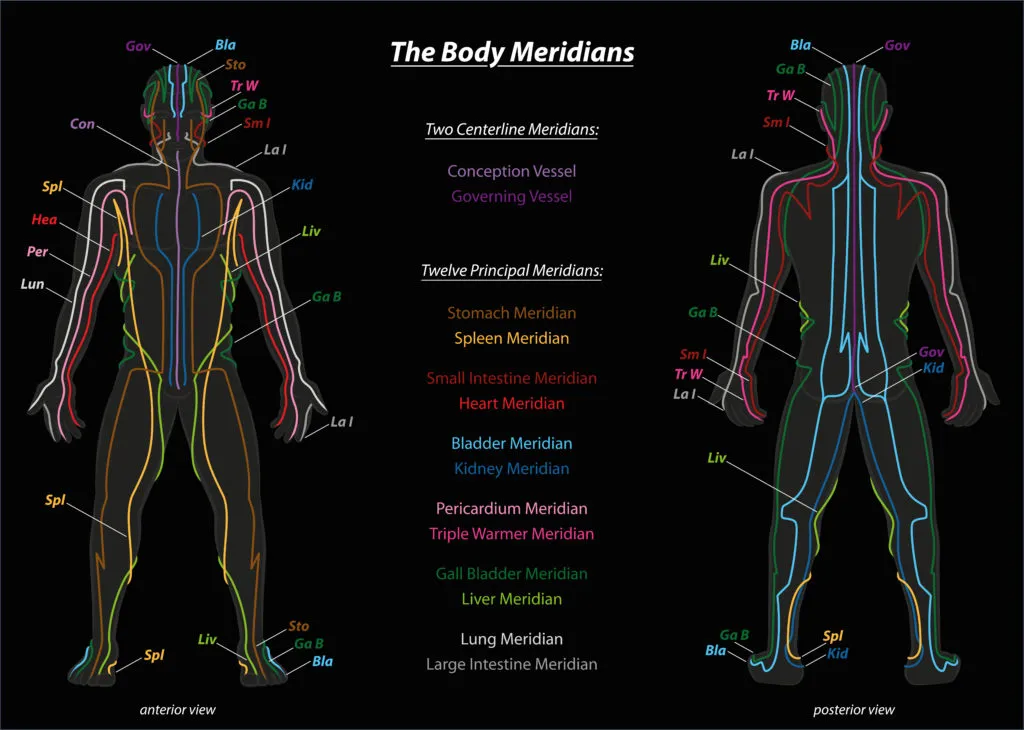
Most of these channels are the 12 so called Organ Channels, the Zhang Fu, however, there is another set of eight “Extraordinary Channels”, also known as the eight “Congenital Channels”. I will focus on the three most important ones in particular, which are of relevance to the present article’s thesis. We’ll get to that in a moment. The three are:
- Du Mai (Sea of Yang), i.e. the Governing Vessel, which runs up the back,
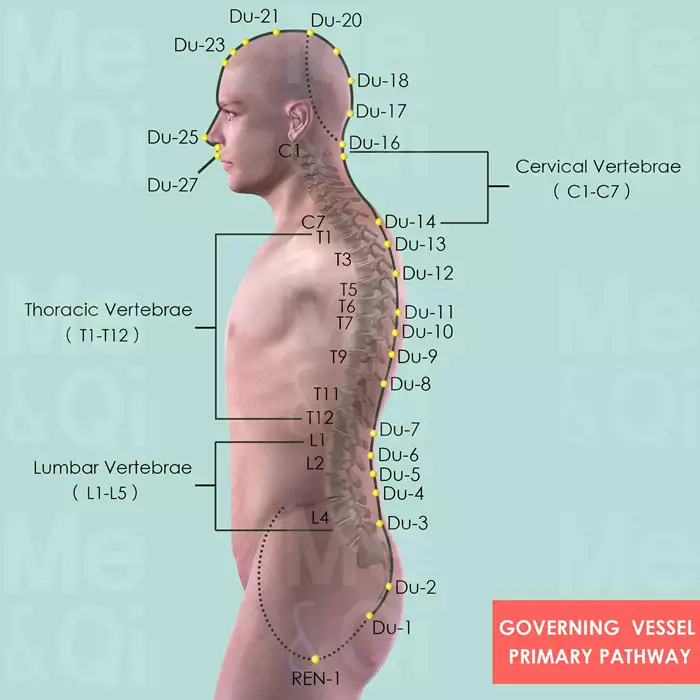
- Ren Mai (Sea of Yin), i.e the Conception Vessel, down the front of the body,
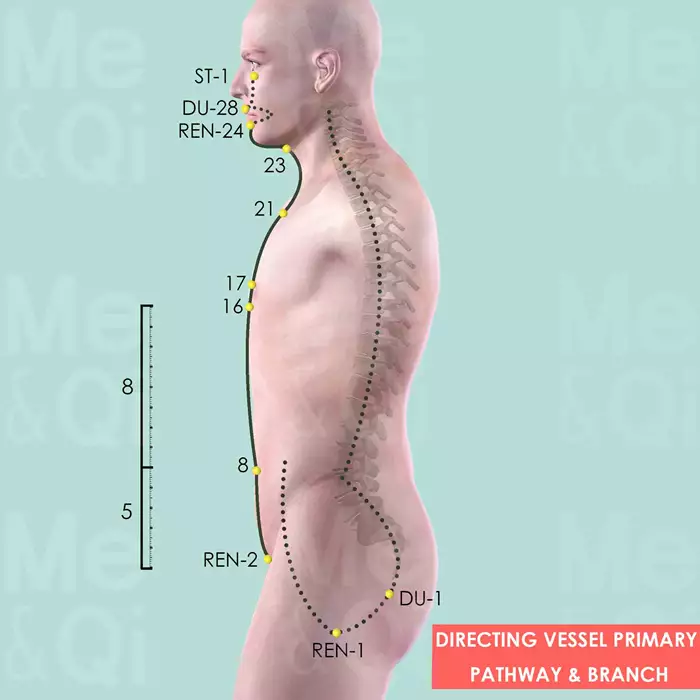
- Chong Mai (Sea of Blood), i.e. the Thrusting Channel or Penetrating Vessel – this is the energetic central axis, running deep inside the body. For those more familiar with Kundalini Yoga, this is equivalent to the Sushumna Nadi, the central energetic axis of the body.
Congenital Channels, including these three, are the first meridians to form, already during embryonic development, preceding the formation of the 12 primary organ channels. This sequence is rooted in their role as foundational energetic structures that regulate the body’s most fundamental processes. In fact, the Chong Mai forms first, during the first cell division, followed by the other two.
Damo Mitchell, a recognized authority on Daoist internal arts (Neidan) and Traditional Chinese Medicine, describes the Ren, Du, and Chong as part of the “eight congenital meridians,” which are fundamental during embryonic development. These meridians “transport vital energetic information which helps in our development prior to birth.” They are responsible for forming the energetic matrix that underpins the physical and energetic body.
After birth, according to Mitchell, “the energy here slows down considerably and the congenital meridians serve mainly as reservoirs for the Qi which later reaches the acquired meridians.” In other words, while their primary, formative activity diminishes after birth, these vessels do not stop functioning. Instead, their role shifts: they become deep reservoirs that support and regulate the 12 primary (zang-fu) channels as the latter “come online” and take over the day-to-day energetic regulation of the body.
Damo emphasizes that through internal practices such as Nei Gong, it is possible to “reverse this process and restore a healthy degree of movement in the congenital meridians.” This means that, although their energetic prominence lessens after birth, they remain accessible and can be reactivated or strengthened through advanced Daoist practices, continuing to play a vital role in health and spiritual development throughout life.
My History with Shifting
The Rastal shifting method, without going into much detail, as mentioned before consists of approximately 28 shifts downward through one’s experience, we could say from crown towards the perineum, followed by 4 or 5 shifts backwards or inwards. We are also instructed to shed a layer, like our skin, every time we shift back/in.
The way Rastal organizes these 28 Positions is as follows:
- 4 initial locations, followed by:
- 4 by 6 Regions, for a total of 24 locations, grouped by certain qualities they seem to share.

Just over three years ago, in June of 2022, long before I had heard about any of this, inspired by a Tibetal Buddhist practice from Patrul Rinpoche, I stumbled across a backwards movement not unlike the one used in the later stages of the Guided Shifting. I didn’t have any real instructions, I had no idea what I was really doing, but every time I did it, it would cause interesting states of consciousness, so I kept doing it, and kept investigating.
I should mention that I’m a life-long Tai Chi practitioners, and part of the method used in Standing Post exercise in our lineage has to do with sinking downwards, as well as sinking inwards at later stages. The way it is done is not exactly the same, but I have been sinking down for over a decade. I didn’t know how to stabilize these shifts but having been sinking for a decade, and now sinking backwards in my own consciousness, it was doing something mysterious and magical to me.
Long story short, I kept moving my center backwards for a good year and a half, going through some powerful changes, when, a year and a half ago, in January 2024, I experienced a classical style “first awakening”, the Kensho or whatever we want to call it. The awakening caused a honeymoon period, as is usually the case. It was a rather short one, a month tops, very clear for around 3 weeks and then slowly faded.
Now, in hindsight, those 3 weeks, I cycled through all of the experiences described by the Martin Matrix and Rastal’s map I shared above, at the rate of 1-2 locations a day. These all happened spontaneously at that point, I was not even practicing anything anymore, I had never even heard of those experienced, I was simply enjoying the honeymoon. I had no idea this could end at the time, I felt very awake and free, completely satisfied.
I’m mentioning all of this because, when I went through Jason Soll’s program a couple of months ago, I did not have those experiences again. These experiences are meant to last for a few hours to a few days each, not something permanent, and not something you can repeat. It’s the novelty of the location that causes these temporary, and often subtle alterations in one’s experience. However, a couple of the people who have done the program that I personally know, have had experiences more or less consistent with the description.
I have also benefited greatly from doing the program, even though I did not have a repeat of the experiences – every shift stirred up significant shadow material and was extremely helpful in clearing much more of it up (in combination with the Sound bubbling tech). It is known that the first awakening cleans up a significant amount of the shadow material, but almost never the whole of it. something like a third of the vasanas is typically cleared up, which causes the honeymoon, like a bomb clearing the sky of all clouds, temporarily. Then the other two thirds coalesce again, bringing the dark night a few months later. And oh boy, was my dark night dark!
The Energetics of the Positions
Going through the Guided Shifting program, it became obvious to me that the shifts were energetic and somatic, the center of consciousness was moving through the energetic structures of the body, and in particular through the three Congenital Meridians, as I’ll describe hereafter.
First I should mention that the Ren and Du channels map directly onto the autonomic nervous system (ANS), with the Du Mai corresponding to the sympathetic nervous system and the Ren Mai to the parasympathetic nervous system. This functional alignment is rooted in their roles as the primary regulators of Yang and Yin energies in the body, respectively.
Du Mai (Governing Vessel) and Sympathetic Nervous System
- Yang correspondence: The Du Mai governs all Yang meridians and embodies the body’s activating, mobilizing energy. It is functionally analogous to the sympathetic nervous system, which drives the “fight-or-flight” response.
- Physiological manifestations:
- Stimulates alertness, spinal strength, and thermogenesis.
- Pathology includes tension, anxiety, and hyperarousal states when imbalanced.
- Pathway: Flows along the spine (governing Yang regions), influencing adrenal function and stress responses. Ren Mai (Conception Vessel) and Parasympathetic Nervous System
- Yin correspondence: As the “Sea of Yin,” the Ren Mai promotes rest, digestion, and tissue repair. It mirrors the parasympathetic nervous system’s “rest-and-digest” functions.
- Physiological manifestations:
- Regulates reproductive health, fluid metabolism, and organ nourishment.
- Imbalance leads to fatigue, poor digestion, or reproductive issues.
- Pathway: Runs anteriorly (front midline), connecting organs involved in nourishment and recovery.
It is well known from Tai Chi practice, that pretty much the human condition has to do with an overstimulated sympathetic nervous system, which consists of a chronically activated fight/flight/freeze response – the mechanism is described as Qi rising to the head. As an example, when you get scared, the energy rises, you become top heavy, the breath rises higher in the chest. Rather than allowing for a deep, relaxed, belly breathing, you get quick, shallow breaths, knot in your throat, and so on. Moreover, the back tends to raise up when afraid or aggressive, and not only in humans.
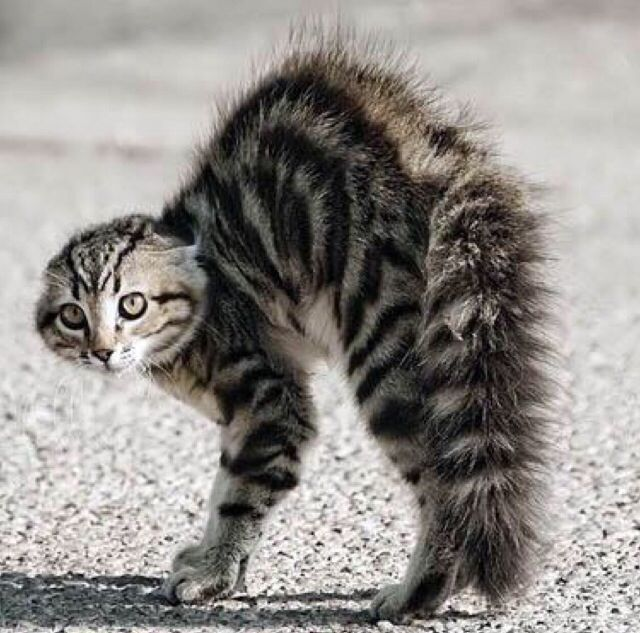
This is what we’re referring to when we’re speaking of an overactive sympathetic system, however, it should not be understood that this only happens when scared, when afraid for one’s life. No, this is the state the average human is in, all of the time, to some degree. Whereas other martial arts seek to use the fight or flight response for aggression, part of the goal in Tai Chi training is to overcome our fight or flight response entirely, for health, relaxation but also martial desirable outcomes.
Now, notice how the the Du channel rises up the back, and then descends over the forehead, all the way to the palate. And it is in the mouth that the Ren channel begins. In Chinese Internal Arts practice, such as Tai Chi and Qi Gong, we connect the tongue to roof of the mouth to close this circuit, connecting the Ren and Du channels together. They are again connected at the other end, the center of the perineum, forming a closed loop. Some might know this as the Microcosmic Orbit.
So it seems clear that the fearful and stressful human condition, shifts one’s center of experience some time after birth, moving it up the spine, towards the head, possibly the crown. We become ungrounded, not connected to our lower body, and not having the parasympathetic system perform its function fully. We never truly rest, never truly relax, never truly let go, in our daily lives.
So, the striking part is that the Chinese have identified exactly 24 acupuncture points along the Ren meridian, from where it starts at the mouth, to where it ends, at the perineum. So it seems to me very plausible, that shifting into these “relaxing qualities”, as Jason Soll calls them, we are shifting into the parasympathetic system, gradually moving towards the most rooted position. The process begins with 4 shifts down from the crown, or maybe the forehead, where most modern people “live” from, in order to reach the beginning of the Ren channel, and then the 4 regions of 6 Positions each follow, all the way to the end of the channel, i.e. the perineum. Personal experience seems to confirm this.
The Backward Shifts into Chong Mai
This central axis of the body exists in many systems, not only the Thrusting Channel in TCM, but also the Sushumna Nadi (channel) in Yogic systems, such as Kundalini Yoga, as previously mentioned. They are equivalent.
While I couldn’t find an equivalent reason for the 4 or 5 shifts in and back of the later stages of guided shifting, I did find an equivalent in the Yogic system. It turns out the actual central axis is represented as 4 concentric tubes, with the Sushumna Nadi as the outermost layer, followed by the Vajra Nadi, then the Chitrini Nadi, and finally, Brahma as the inner most Nadi (channel).
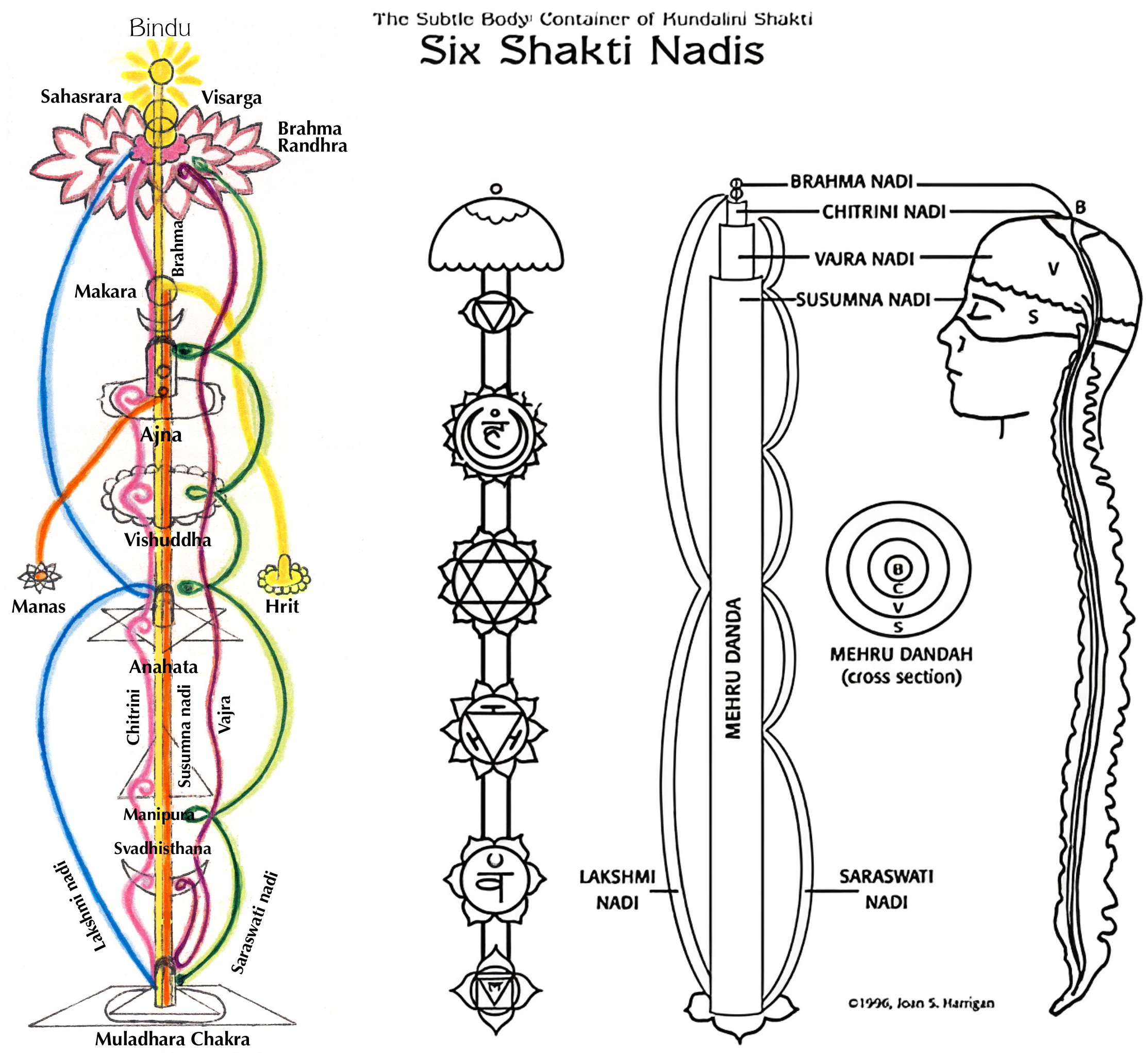
Remember the instructions for the later shifts: sink back and allow a layer of yourself to fall away. It’s clear we’re going deeper and deeper inside out own central axis. This also reflects the Tai Chi method or first sinking down, and later also sinking in. Peeling the onion to sink deeper into one’s core seems an apt image here.
